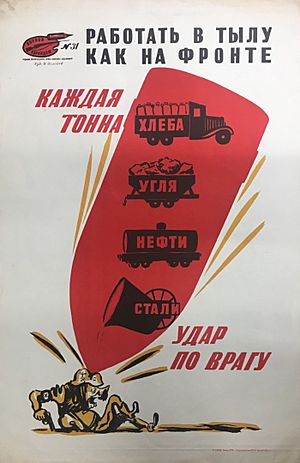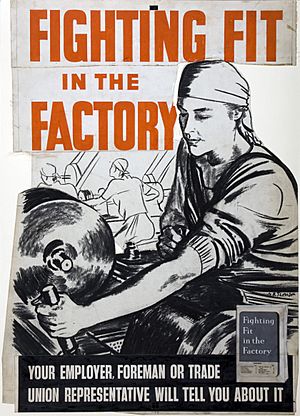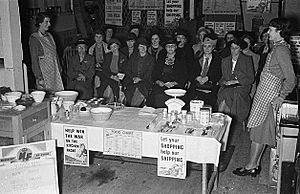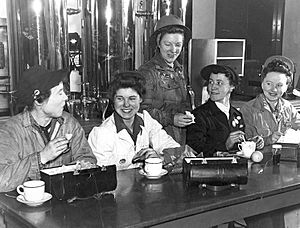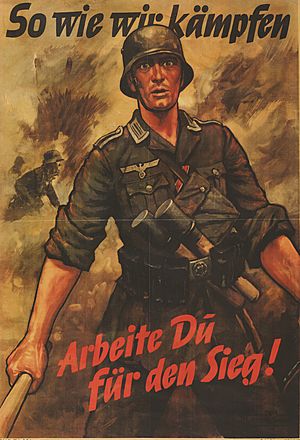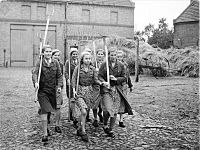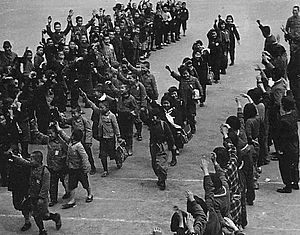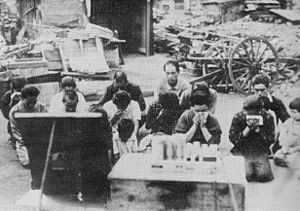Home front during World War II facts for kids
The "home front" during World War II was all about what people who weren't soldiers did to help their country win the war. World War II was a "total war," meaning everyone, not just soldiers, was involved. What happened at home, like making weapons and supplies, was super important for both the Allied and Axis powers.
Life on the home front greatly affected how the war turned out. Governments got involved in new ways, like controlling how much food people could buy (called rationing), deciding who would work where, defending against air raids, and helping people move to safer places. People's spirits and how they felt were also shaped by leaders and propaganda (messages to influence opinions). Many women joined the workforce in huge numbers, which was new for the time.
Countries learned from their experiences in World War I. Their ability to produce goods was key to supporting their armies. To boost morale and help the war effort, people collected scrap materials like metal, rubber, and old clothes. These "drives" made people feel like they were truly helping. Governments also tried to stop negative rumors.
The main powers spent a lot of their country's total income on making weapons. The Allies made about three times more weapons than the Axis powers.
| Country/Alliance | Year | ||||||
|---|---|---|---|---|---|---|---|
| Average 1935-39 |
1940 | 1941 | 1942 | 1943 | 1944 | Total 1939–44 |
|
| U.S.A. | 0.3 | 1.5 | 4.5 | 20.0 | 38.0 | 42.0 | 106.3 |
| Britain | 0.5 | 3.5 | 6.5 | 9.0 | 11.0 | 11.0 | 41.5 |
| U.S.S.R. | 1.6 | 5.0 | 8.5 | 11.5 | 14.0 | 16.0 | 56.6 |
| Allies Total | 2.4 | 10.0 | 20.0 | 41.5 | 64.5 | 70.5 | 204.4 |
| Germany | 2.4 | 6.0 | 6.0 | 8.5 | 13.5 | 17.0 | 53.4 |
| Japan|0.4 | 1.0 | 2.0 | 3.0 | 4.5 | 6.0 | 16.9 | |
| Axis Total | 2.8 | 7.0 | 8.0 | 11.5 | 18.0 | 23.0 | 70.3 |
Contents
- Allied Nations: Life During Wartime
- Belgium: Under German Control
- China: A Nation Under Attack
- France: Defeat, Occupation, and Resistance
- Netherlands: The Hunger Winter
- Poland: Nazi Hunger and Uprisings
- Soviet Union: Fighting on Their Own Land
- United States: Production and Change
- Britain and Commonwealth: Total Mobilization
- Mexico: Joining the Allies
- Axis Nations: Life During Wartime
- Famines During the War
- Housing Destruction
- Images for kids
- See also
Allied Nations: Life During Wartime
The Allied countries called themselves the "United Nations" even before the actual organization was formed. They promised to support the Atlantic Charter of 1941. This Charter outlined their goals for the war, like not taking land from others, letting people choose their own governments, and ensuring everyone had access to resources and a better life.
Belgium: Under German Control
Belgium was a neutral country, but Germany suddenly invaded it in May 1940. The Belgian army quickly fell apart. King Leopold III stayed in Belgium under German control, even though his government wanted him to flee to Britain.
The Belgian government workers generally cooperated with the Germans. Some groups supported the invaders and encouraged young men to join the German army. However, small but active resistance groups, often led by Communists, secretly sent information to the Allies. The Nazis also targeted the 70,000 Jewish people living in Belgium, killing many of them.
The Germans wanted to use Belgium's factories to make war supplies. But their rules caused severe shortages for Belgians. Factory production dropped sharply after 1942. Workers went on strike, sabotaged equipment, and moved to the countryside. Allied bombing and food shortages also slowed things down.
The Allies took back Belgium in September 1944. The Germans briefly returned during the Battle of the Bulge in December 1944 but were finally pushed out in January 1945.
China: A Nation Under Attack
China suffered the second-highest number of deaths in the entire war. Many civilians in areas taken over by Japan faced large-scale killings. In some places, the Japanese army used new biological weapons on Chinese civilians, causing many deaths. Tens of thousands more died when Chinese troops broke river walls to stop the Japanese advance. Millions of Chinese also died from famine during the war.
Japan had captured major coastal cities like Shanghai early in the war. This cut off the rest of China from its main sources of money and industry. Millions of Chinese moved to safer western regions to avoid the invasion. Whole factories and universities were moved so that society could keep functioning. Japan responded by bombing the new capital, Chongqing, many times.
China received a lot of help from the United States. However, China did not have enough roads or railways to properly arm or even feed its own soldiers, let alone its civilians.
China was split into three main areas. The Nationalists, led by Chiang Kai-shek, were in the southwest. The Communists, led by Mao Zedong, controlled much of the northwest. Coastal areas were occupied by the Japanese, and civilians there were treated very harshly.
France: Defeat, Occupation, and Resistance
After a very quick defeat in June 1940, France was out of the war. Part of France, with its capital in Vichy, became a partner of the Germans. A strong Resistance movement grew as the Germans took over the northern half of the country.
The Germans captured 2 million French soldiers and kept them as prisoners of war in Germany. They used these prisoners to make sure France cooperated. The Vichy French government worked closely with the Germans, sending food, machines, and workers to Germany. Hundreds of thousands of French people were forced or volunteered to work in German factories.
Despite this, the Resistance movement was strong. The Nazis and French police fought fiercely against them. Most Jewish people were rounded up by the French police and given to the Germans, who sent them to death camps.
French Women During the War
The 2 million French soldiers held in Germany meant their 800,000 wives faced great worry and separation. The Vichy government promoted traditional roles for women. After the war, French women gained the right to vote and more legal rights.
Food Shortages in France
Women faced shortages of almost everything, and their husbands were away in prison camps. The rationing system was strict and poorly managed. This led to people being very underfed, a large black market, and anger towards the government's food control. The Germans took about 20% of France's food, which caused big problems for French families. Farm production in France fell by half because of a lack of fuel, fertilizer, and workers. Even so, the Germans took half the meat and 20% of the produce.
Food problems quickly affected French stores, which lacked most items. The government rationed food, but German officials set the rules, and hunger was common, especially for young people in cities. Lines at shops grew longer. Some people, including German soldiers, benefited from the black market, where food was sold without coupons at very high prices. Farmers sold meat on the black market, leaving less for regular stores. Fake food coupons also appeared. Buying directly from farmers in the countryside and trading things for cigarettes became common. These activities were against the rules and could lead to fines. Food shortages were worst in big cities. Many people lacked enough vitamins and suffered from poor nutrition.
People were given advice on eating healthier and growing their own food. Slogans like "Digging for Victory" appeared on posters. These efforts were hard to do in cities. But in remote villages, secretly butchering animals, growing vegetables, and having milk helped people survive. The official food ration provided very little food, so people relied on home gardens and the black market.
Netherlands: The Hunger Winter
The Dutch famine of 1944, known as the Hongerwinter ("Hunger winter"), was caused by Germany in the occupied western parts of the Netherlands during the winter of 1944–1945. A German blockade stopped food and fuel from reaching these areas. About 4.5 million people were affected, and 18,000 died, even with emergency soup kitchens trying to help.
Poland: Nazi Hunger and Uprisings
The Nazi plan was to quickly kill Jewish people in Poland and slowly starve Poles to make them leave. This would allow German settlers to move in. Nazis tried to get Poles to work in Germany by offering better food rations to families who had members working there. Ethnic Germans in Poland received good food and could shop in special stores. The German occupiers created very strict food controls, with harsh punishments for black market activities. This led to many deaths from malnutrition and fewer births.
By mid-1941, Germans in Poland received enough calories, but Poles received much less, and Jewish people in ghettos received very little, barely 7.5% of their daily needs.
Food Rations in Nazi-Occupied Poland (December 1941)
| Nationality | Daily Calorie intake |
|---|---|
| Germans | 2,310 |
| Foreigners | 1,790 |
| Ukrainians | 930 |
| Poles | 654 |
| Jews | 184 |
Warsaw Ghetto Uprising (1943)
On September 1, 1939, Germany invaded Poland. During the German occupation, there were two major civilian uprisings in Warsaw. The first happened in 1943, in an area the Germans called the Ghetto Warschau. The Germans built high walls around the Warsaw Ghetto and forced 550,000 Polish Jews into it. Conditions were terrible, and many died from hunger. In 1942, the Germans moved 400,000 ghetto residents to Treblinka, where they were killed. By April 19, 1943, when the Ghetto Uprising began, only 60,000 people were left. In the next three weeks, almost all of them died as the Germans fought and destroyed the ghetto buildings.
Warsaw Uprising (1944)
The second uprising by Poles began on August 1, 1944. The Polish underground army, called the "Home Army", knew the Soviet army was close. They wanted to free Warsaw, like the French Resistance had freed Paris. However, Joseph Stalin (the Soviet leader) wanted his own Communist leaders to control Poland. So, he stopped the Soviet attack and let the Germans crush the uprising. Over 63 days, 250,000 Poles died. After the Germans forced all surviving people to leave, Hitler ordered that any remaining buildings be blown up. 98% of Warsaw's buildings were destroyed.
Soviet Union: Fighting on Their Own Land
When Germany invaded the Soviet Union in 1941, they quickly advanced towards Moscow and Leningrad. Most Soviet factories that couldn't be moved were destroyed or captured. Farming was stopped, and crops were left in the fields, causing hunger.
In an amazing feat, 1,523 factories were taken apart and shipped east to places like the Caucasus, Central Asia, the Ural, and Siberia. This included tools, plans, and skilled workers.
The entire Soviet Union focused on the war. People were used to shortages, but conditions were still very harsh. World War II was especially terrible for Soviet citizens because it was fought on their land, causing massive destruction. In Leningrad, under German siege, over a million people died from starvation and disease. Many factory workers were teenagers, women, and elderly people.
The government started rationing in 1941 for many foods. Rations stayed mostly the same during the war. Food bought outside the rationing system was often too expensive for most people. Farmers didn't get rations and had to rely on their own crops. Most rural farmers struggled, but some sold extra food at high prices, becoming rich until a currency change in 1947 wiped out their wealth.
Despite the tough times, the war made Soviet people feel more united and proud of their country. The government used propaganda to encourage people to protect their "Motherland" against the German invaders. Religion, which was usually discouraged, was even used to motivate people.
Soviet society changed a lot. Many people got married quickly in 1941 before being separated by the war. The marriage and birth rates then dropped sharply. Mothers with several children received special honors and money.
Surviving the Siege of Leningrad
The city of Leningrad suffered more than any other Soviet city. Hunger, malnutrition, disease, starvation, and even cannibalism became common during the siege, which lasted from September 1941 to January 1944. People lost weight, became weak, and were more likely to get sick. If malnutrition lasted too long, its effects were permanent. People's loyalty could disappear if they were hungry enough; they would steal from family to survive.
Only some Leningrad citizens survived. Many were evacuated before the siege, and more escaped later, especially when Lake Ladoga froze, creating an "ice road" to safety. People with important jobs or connections sometimes used them to leave. Some factory owners even stole money to escape.
Most survival strategies involved staying in the city and finding ways to cope. Working in factories was a good option because many factories had more food and heat. Workers received larger rations, and factories that made important goods often had electricity. Factories also offered support like clinics and cleaning services. Even so, factory workers sometimes ate glue or horsemeat when food was very scarce. But factory work was the most reliable way to survive, and in some food production plants, no one died.
Other ways to survive included trading goods and farming on private land. Black markets grew as people traded more, especially soldiers with civilians. Soldiers had extra food, and civilians had warm clothes to trade. Planting vegetable gardens in spring became popular because people could keep everything they grew. This also helped morale, which was almost as important as food.
Some desperate Soviet citizens turned to crime, mostly stealing food and ration cards. This could be deadly for a hungry person if their card was stolen. Stealing food was severely punished, and people could be shot for taking a loaf of bread. More serious crimes like murder and cannibalism also happened. Special police squads were set up to fight these crimes, and about 1,500 people were arrested for cannibalism by the end of the siege.
United States: Production and Change
In the United States, farming and other production greatly increased. People were encouraged to plant "victory gardens," which were small home vegetable gardens. Children sometimes helped with these. During the war, the traditional roles of men and women changed. Women's roles at home expanded to include the "home front," while men's public roles were seen as fighting overseas.
The Philippines: Japanese Occupation
The Philippines was an American territory that was supposed to become independent in 1946. Japan invaded and quickly took over the islands in early 1942. The Japanese military immediately set up a new government.
However, the Japanese rule was met with strong resistance from underground groups and guerrilla fighters. The Philippine Army and remaining US soldiers continued to fight the Japanese. Their efforts were so effective that by the end of the war, Japan controlled only 12 out of 48 provinces.
As in most occupied countries, crime, stealing, corruption, and black markets were common. Japan wanted to use the islands to get farm products for its industries. For example, they tried to grow cotton on sugar lands, but it failed badly because they lacked seeds and skills. Jobless farm workers moved to cities, where there was little help and few jobs.
Living conditions were bad throughout the Philippines. Transportation was difficult, food was scarce, and there were famines and diseases.
The Japanese tried to remove all Western and American culture. They faced strong resistance when they tried to weaken the Catholic Church. Filipinos felt morally superior to the brutal Japanese and rejected their ideas. Newspapers and media were strictly controlled. The Japanese tried to change schools and force people to learn Japanese. They also formed neighborhood groups to spy on people.
Britain and Commonwealth: Total Mobilization
Britain and its Commonwealth countries used conscription (forcing people to join the military) to raise forces. This was different from World War I, when too many men who were needed at home volunteered for the army.
Britain: United for Victory
Britain's complete effort to mobilize everyone and everything helped them win the war. The public strongly supported the war, which was seen as a "people's war." This led to hopes for a better welfare state (government support for citizens) after the war.
Making Weapons
In mid-1940, the Royal Air Force (RAF) fought the Battle of Britain and lost many planes. The government decided to focus on making only five types of aircraft to produce them faster: Wellingtons, Whitley Vs, Blenheims, Hurricanes, and Spitfires. These planes were given top priority for materials, equipment, and workers. Cost was not an issue. New fighter plane deliveries increased greatly, helping the RAF win the Battle of Britain. Starting in 1941, the US sent Britain weapons and supplies through Lend-Lease.
Rationing Food and Goods
Food, clothing, petrol, leather, and other items were rationed. Fresh items like fruit were not rationed. Luxury goods were very hard to get, though there was a black market. Families also grew "victory gardens" to grow their own vegetables. Many goods were saved to be turned into weapons later, like fat for explosives. People in the countryside were less affected by rationing because they had more access to unrationed local products and could grow their own food.
The rationing system improved when it switched to a points system, allowing families to choose what they needed most. Food rationing also helped improve the quality of available food. Most Britons liked that rationing brought equality and guaranteed a decent meal at a fair price.
Evacuating Children
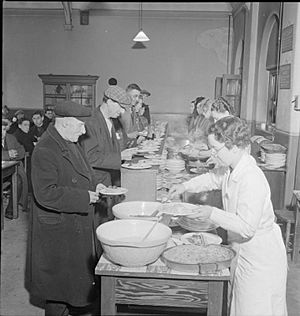
Early in the war, it was expected that major British cities, especially London, would be bombed by German planes. This happened during The Blitz. Millions of children and some mothers were moved from London and other big cities to safer parts of the country when the war started. However, many later returned home. When the Blitz began in September 1940, they evacuated again. Discovering the poor health of some evacuees shocked many Britons and helped prepare the way for future social welfare changes. Children were evacuated if their parents agreed, but sometimes they had no choice. Children could only take a few items, like a gas mask, books, money, clothes, a ration book, and small toys.
The Welfare State
An Emergency Hospital Service was set up at the start of the war, expecting many casualties.
A common idea was to expand the welfare state as a reward for people's wartime sacrifices. This was suggested in a famous report by William Beveridge. It recommended making different types of aid more organized. Unemployment and sickness benefits would be for everyone. There would be new benefits for mothers. The old-age pension system would be updated. A full National Health Service would provide free medical care for everyone. All major political parties supported these ideas, and they were mostly put into action after the war.
Canada: Stepping Up Production

Canada joined the war on September 10, 1939. War production quickly increased and was managed by the government. Unemployment disappeared.
Canada became a major training center for Allied pilots. Many Canadian men joined the military, so women took their places in factories and other jobs to help the war effort. Later in the war, it became difficult to hire men for many civilian jobs.
Shipyards and repair facilities grew hugely, building over a thousand warships and cargo vessels.
Canada increased food production, but sent so much to Britain that food rationing had to be introduced. In 1942, Canada sent Britain 25% of its total meat production and large amounts of cheese and eggs.
Ethnic Minorities
About 20% of Canada's population was not of British or French origin. The government wanted to include these European groups, unlike in World War I when Ukrainians and Germans were put in internment camps. For Germans, Italians, and especially Japanese, the government watched them closely for signs of loyalty to their home countries. These fears turned out to be unfounded. However, in February 1942, 21,000 Japanese Canadians were rounded up and sent to internment camps, similar to those in the US. Most lived in British Columbia. In 1945, they were released but not allowed to return to British Columbia, or they could go to Japan. Most moved to the Toronto area.
Women in the Workforce
Canadian women responded to calls to save, recycle, and salvage needed supplies. They saved fats and grease, collected recycled goods, and shared tips on how to make the most of recycled items. Volunteer groups led by women also prepared packages for soldiers overseas and for prisoners of war.
World War II created a huge need for workers. Without women, the economy would have collapsed. By late 1944, twice as many women were working full-time in Canada's paid workforce as in 1939. Women took on demanding jobs and still found time to make jam, clothes, and volunteer to help the men overseas.
Australia: A Nation Transformed
The Australian government greatly increased its powers to manage the war effort. Australia's factories and people focused on supporting Australian and American armed forces.
Australia entered the war in 1939. By 1943, 37% of Australia's total income was spent on the war.
The Curtin Labor Government took over in October 1941 and boosted the war effort, with rationing of fuel, clothing, and some food. When Japan entered the war in December 1941, the danger was close. All women and children were moved from Darwin and northern Australia. The government took control of all income taxes in 1942, gaining new powers.
Manufacturing grew quickly, especially making guns and aircraft. The number of women working in factories increased significantly. The arrival of thousands of Americans was a relief, as they could protect Australia when Britain couldn't. The US sent Australia supplies, and Australia returned similar amounts in services and food.
Three major events happened on Australian land: the Bombing of Darwin, the attack on Sydney Harbour, and the Cowra breakout.
New Zealand: High Mobilization
New Zealand, with a population of 1.7 million, was highly involved in the war. The Labour party was in power and supported unions and the welfare state. The armed forces reached 157,000 soldiers in September 1942; 135,000 served abroad, and 10,100 died. Farming expanded, sending record amounts of meat, butter, and wool to Britain. American forces were also fed. The nation spent a lot on the war, with money coming from taxes, loans, and American Lend Lease. It was a time of prosperity as national income soared. Rationing and price controls kept prices from rising too much.
The war greatly increased the roles of women, especially married women, in the workforce. Most took traditional female jobs. Some replaced men, but these changes were temporary and reversed after 1945. After the war, women left male-dominated jobs, and many stopped paid work to return home. There wasn't a huge change in gender roles, but the war sped up job trends that had been happening since the 1920s.
India: A British Colony at War
During World War II, India was a British colony. Britain declared war on behalf of India without asking Indian leaders. This led to Indian political parties resigning.
The British recruited about 2.5 million Indians to serve as soldiers in the Middle East, North Africa, and Burma. India became the main base for British operations against Japan and for American efforts to support China.
In Bengal, a region in India, a stop to rice imports from Burma led to severe food shortages, made worse by poor management. Prices soared, and millions starved because they couldn't afford food. In the Bengal famine of 1943, three million people died.
An anti-British force of about 40,000 men (and some women), called the Indian National Army (INA), formed in Southeast Asia. It was controlled by the Japanese army and did not perform well in combat. Its members were Indian soldiers captured by the Japanese who joined the INA to escape terrible conditions in prison camps.
The Congress Party in 1942 demanded immediate independence from Britain, which Britain refused. Congress then demanded the British immediately "Quit India" in August 1942. But the British arrested tens of thousands of leaders, taking Congress out of the war. Meanwhile, the Muslim League supported the war and gained members and favors from the British, as well as British support for their demand for a separate Muslim state (which became Pakistan in 1947).
Hong Kong: Under Japanese Rule
Hong Kong was a British colony captured by Japan on December 25, 1941, after 18 days of fierce fighting. The population was cut in half, from 1.6 million in 1941 to 750,000 at the end of the war, because many refugees fled. They returned in 1945.
The Japanese imprisoned the British rulers and tried to win over local Chinese business leaders by giving them roles on advisory councils. This worked well for Japan, leading to cooperation from both the rich and middle classes, with less violence than in other Chinese cities. Hong Kong became a Japanese colony, with Japanese businesses replacing British ones. However, Japan faced severe problems getting supplies, and by 1943, Hong Kong's food supply was difficult.
The Japanese rulers became more brutal and corrupt, and the Chinese leaders became unhappy. When Japan surrendered, Hong Kong smoothly returned to British rule.
Mexico: Joining the Allies
When the Attack on Pearl Harbor happened on December 7, 1941, Mexico broke off diplomatic ties with the Axis nations but stayed neutral. Anti-Axis feelings grew as many Mexicans felt the attack was unprovoked. A security zone was set up in Baja California in case of a Japanese attack. 9,000 Japanese people were forced to move to either Mexico City or Guadalajara.
When Nazi U-boats started targeting Mexican oil tankers in May 1942, the government and people became more negative towards the Axis, leading to an official declaration of war on Germany. The Mexican government also became more active in stopping Axis propaganda and started its own propaganda network. From May to August 1942, the country was very enthusiastic about the war.
However, enthusiasm began to fade in August. Many farmers and factory owners changed their operations to produce goods for wartime trade agreements with the United States, which meant fewer goods for Mexicans. Prices soon began to rise, and many found their paychecks didn't buy as much. As the war continued, President Manuel Ávila Camacho faced pressure to deal with rising prices and shortages of food and other goods.
Axis Nations: Life During Wartime
Germany: Total War and Forced Labor
Germany had not fully prepared for a long war in 1939 or even 1941. Society continued much as it had before the war. It wasn't until 1943, under Albert Speer (the minister of armaments), that Germany finally put its entire economy and workforce into war production. Instead of using all available Germans, it brought in millions of slave workers from conquered countries. These workers were treated badly and produced little. Germany's economy was simply too small for a long, all-out war. Hitler's plan was to win quickly with surprise attacks, but this failed with defeats in Russia and against the economic power of the Allies.
Forced Labor in Germany
Instead of helping the economies of the occupied nations, the Nazis took their machinery and trains. They also took most of their factory output and large amounts of food (like 15% of France's food). They forced the conquered people to pay for the German military occupation.
The Nazis forced 15 million people to work in Germany, including prisoners of war. Many died from terrible living conditions, mistreatment, malnutrition, and executions. At its peak, forced laborers made up 20% of the German workforce. They were vital to Germany's use of conquered lands and were especially used in making weapons and farming. For example, 1.5 million French soldiers were kept as prisoners and forced workers in Germany. In 1943, 600,000 French civilians were forced to move to Germany to work in war factories.
Germany's Wartime Economy
Germany had almost twice the population of Britain (80 million versus 46 million), but it needed far more workers to produce food and energy. The blockade of Germany (1939–1945) stopped Germany from getting food and minerals from other countries. Britain could still import food and used only a million people (5% of its workforce) on farms, while Germany used 11 million (27%). To build its synthetic oil plants, Germany needed huge amounts of steel and labor. Britain imported its oil. To overcome these problems, Germany used millions of forced laborers and prisoners of war. By 1944, they had brought in over 7 million foreign workers.
Rationing in Germany
Rationing in Germany started in 1939 when the war began. Hitler initially thought strict rationing would make people stop supporting the war. The Nazis were popular partly because Germany was doing well, and Hitler didn't want to lose that support. He believed that food shortages had greatly hurt morale in World War I, leading to defeat.
Despite rationing, civilians had enough food and clothing at first. One observer wrote that "the German people for two years of war ate amazingly well." For example, the meat ration was 500 grams per week per person. However, after Germany invaded the Soviet Union in June 1941, this changed. The meat ration dropped to 400 grams per week and then even lower. By late 1941, the German people were "undernourished." The system gave extra rations to men in heavy industry but very low, starvation rations to Jewish people and Poles in occupied areas.
The rations were enough to live on, but there were no luxuries. Whipped cream, chocolates, and rich cakes were unavailable for years. Meat couldn't be eaten every day. Other items, like coffee, were not rationed but simply disappeared because they had to be imported. Vegetables and local fruit were not rationed, but imported fruits like citrus and bananas were gone. In rural areas, farmers still brought their products to markets. Many people kept rabbits for meat when it became scarce in shops, and children often cared for them.
By spring 1945, food distribution and the rationing system were collapsing due to transportation problems and the rapid advance of Allied armies. In Berlin, at the start of the Battle of Berlin, authorities announced a special extra food ration on April 20, 1945. Berliners called these "Ascension-day rations," joking that "with these rations we shall now ascend to heaven."
Nursing and Displaced Persons
Germany had a large and well-organized nursing service. The DRK (Red Cross) handled military nursing and came under partial Nazi control. Red Cross nurses worked in military hospitals near the front lines, risking bombing attacks. Some were even awarded the Iron Cross for bravery. They were among the 470,000 German women who served with the military.
When Germany was conquered in 1945, 11 million foreigners, called "displaced persons" (DPs), were freed. These were mainly forced laborers and prisoners of war. Returning them home was a top priority for the Allies. Organizations like the UNRRA and Red Cross provided food, clothing, shelter, and help to return home. Millions were sent back to their home countries.
Refugees
In 1944–45, over 2.5 million ethnic Germans fled from Eastern Europe, hoping to reach Germany before the Russians arrived. Half a million died during this journey. The survivors were placed in refugee camps in East and West Germany for years.
Japan: A Nation United for War
The Japanese home front was very organized, block by block, with full food rationing and strict controls over workers. The government used a lot of propaganda and planned every detail for mobilizing people, managing supplies, building air raid shelters, and moving children and civilians from cities that might be bombed. Food supplies were very tight before the heavy bombing began in late 1944, then became a crisis. There was only a small increase in women joining the workforce. The government strongly encouraged saving money and not buying unnecessary things, and housewives generally followed this. The welfare minister said, "In order to secure its labor force, the enemy is drafting women, but in Japan, out of consideration for the family system, we will not draft them."
Even in 1944, there were still 600,000 domestic servants in wealthy families, showing that not all women were used for war work. The government wanted to increase the birthrate, even with 8.2 million men in the armed forces (3 million of whom died). Government incentives helped raise the marriage rate, but the number of births stayed steady. Strict milk rationing led to smaller babies.
The government started evacuation plans in late 1943. They began moving entire schools from industrial cities to the countryside, where they were safe from bombing and had better access to food. In total, 1.3 million children were moved with their teachers, but not their parents. When American bombing began in late 1944, 10 million people fled the cities to the countryside, including two-thirds of residents from the largest cities and 87% of children. Only munitions workers and government officials stayed behind. By April 1945, 87% of younger children had been moved.
Civil defense units were turned into combat units, including the Peoples Volunteer Combat Corps, which enlisted civilian men up to age 60 and women up to age 40. Starting in January 1945, the government ran an intense training program to prepare all civilians to fight American invaders using grenades, explosive gliders, and bamboo spears.
Civilian Support and Government Efforts
There was strong civilian support for the war by July 1937. Japan's successful invasion of Manchuria in the early 1930s fueled aggressive foreign policy and strong nationalism. Japanese newspapers and radio helped spread these feelings. The Japanese government soon started educating the public about the war effort. From January 1938, ten minutes of war news were broadcast every day.
The Home Ministry of Japan started more campaigns to get support for the war. For example, citizens were encouraged to avoid luxuries and save money for the state. The government even changed its education system, rewriting ethics textbooks to be more nationalistic and militaristic. Schoolchildren were taught nationalistic songs.
In 1937, a guide called Shinmin no michi (The Way of the Subjects) was given to all Japanese citizens to teach them how to behave. Similarly, the Japanese war ministry issued the Senjinkun (Field Service Code) in 1941, which taught soldiers how to act during wartime. Diaries and letters from civilians show that the government successfully gained massive support for the war. Despite food shortages due to rationing, many Japanese were happy to cooperate. One housewife wrote, "I have the feeling that little by little there will be shortages but that in war, we must aim for frugality even in small ways and we must be careful about waste–for the sake of the country." Such feelings were very common in Japan.
The success of the Japanese government is also shown by the low number of soldiers who left their posts. There were only about 1,000 deserters each year during the six years of World War II. In comparison, about 40,000 Americans and over 100,000 British soldiers left their posts. While there was some resistance in Japan, most people supported the war efforts. In fact, many were ready to fight invaders if they came. In some areas, women practiced fighting with bamboo spears; girls promised to kill at least one invader before they died; children practiced throwing balls, imagining they were throwing grenades at the enemy. This was partly due to loyalty to the emperor and fear tactics from the Japanese government, which spread false information that American soldiers would commit terrible acts against civilians. For other Japanese civilians, there was a general feeling of sadness when Japan surrendered. A Japanese teenager wrote in his diary, "Cry! Let's cry until we can't any longer. Later we'll probably see the outpouring of a new power."
| Year | 1939 | 1943 | 1944 |
|---|---|---|---|
| Defectors | 669 | 20 | 40 |
| Deserters | 669* | 1023 | 1085 |
*669 is the combined number of deserters and defectors in 1939.
Food Supply in Japan
Farming in Japan held up well until the bombing started. Production fell significantly by 1945. Worse, imports stopped. The Japanese food rationing system worked well throughout the war, and there were no serious cases of malnutrition. A government survey in Tokyo showed that in 1944, families relied on the black market for some of their rice, fish, and most of their vegetables.
Japan's food supply depended on imports, which were mostly cut off by American submarines and bombing. There was also little deep-sea fishing, so by 1941, the fish ration was mostly squid from coastal waters. This led to a growing food shortage, especially in cities. There was some malnutrition but no reported starvation. Despite government rationing, some families had to spend more than their monthly income on black market food. They would use savings or trade clothes for food.
| Year | 1937 | 1938 | 1939 | 1940 | 1941 | 1942 | 1943 | 1944 | 1945 |
|---|---|---|---|---|---|---|---|---|---|
| Domestic production | 9,928 | 9,862 | 10,324 | 9,107 | 8,245 | 9,999 | 9,422 | 8,784 | 6,445 |
| Imports | 2,173 | 2,546 | 1,634 | 1,860 | 2,517 | 2,581 | 1,183 | 874 | 268 |
| All rice | 12,101 | 12,408 | 11,958 | 10,967 | 10,762 | 12,580 | 10,605 | 9,658 | 6,713 |
Civilian Deaths in Japan
American air bombing of 65 Japanese cities caused between 400,000 and 600,000 civilian deaths. Over 100,000 died in Tokyo alone, and over 200,000 in Hiroshima and Nagasaki combined. The Battle of Okinawa resulted in 80,000–150,000 civilian deaths. About 100,000 Japanese settlers also died trying to return to Japan from Manchuria in the winter of 1945. The total number of Japanese military deaths between 1937 and 1945 was 2.1 million. Most of these deaths happened in the last year of the war and were caused by starvation or severe malnutrition in isolated military bases.
Japanese Women During the War
Traditional family rules made it hard for the government to use women more fully for the war effort. Unmarried women could be forced to work in factories, but social rules stopped married women from doing that kind of work, unlike in Russia, Britain, Germany, and the United States. The absence of so many young men greatly changed marriage, birth rates, and family life. Severe shortages of everyday items, like food and housing, were much harder than government propaganda. Japanese women generally followed orders, and there were no major problems like food riots. Non-Japanese women from colonies like Korea were especially vulnerable.
Historians have looked at the role of women in wartime, especially World War II. Magazines for women, often written by men, focused on their roles as mothers and wives, dealing with housing, food, and money problems while men were at war. Fashion during wartime was also a big topic in these magazines. Japanese textile and fashion industries successfully adapted to wartime shortages and propaganda needs. Magazines for teenage girls stressed that they must follow patriotic demands, giving up their teenage freedoms to become "girls of a military nation" with important home front duties. The evacuation of women and children from major cities, due to fear of Allied bombing, was covered in detail to show willingness to sacrifice for patriotism through stories, news, and photos. The government controlled all media and supervised popular magazines to spread its goals and propaganda.
Conditions at War's End
Health and living conditions worsened after Japan surrendered in September 1945. Most housing in large cities was destroyed just as refugees tried to return from rural areas. Adding to the crisis, 3.5 million returning soldiers and 3.1 million Japanese civilians were forced to return from Imperial outposts. About 400,000 civilians were left behind and never heard from again. Meanwhile, 1.2 million Koreans, prisoners of war, and other non-Japanese people left Japan. The government encouraged more births, which led to an increase in marriages. However, birth rates stayed steady until they dropped by 10% in the last stressful year of the war, and another 15% during the tough postwar period.
American bombing of major cities severely hurt the economy, as did shortages of oil and raw materials when Japanese merchant ships were mostly sunk by American submarines. For example, 24% of Japan's finished steel went to the military in 1937, compared to 85% in 1945. By the end of the war, production was still 100% for steel, but much lower for other important goods like aluminum, machine tools, and cotton fabric.
Famines During the War
Severe food shortages were common in war zones, especially in Europe, where Germany used starvation as a weapon. Japan did not use it as a deliberate policy, but its transportation and distribution systems broke down, leading to famine and starvation among its soldiers on many Pacific islands. Three major famines happened in Asia during the war: Bengal in India, Honan in China, and Tonkin in Vietnam. In each famine, at least two million people died. They all happened in crowded areas where farming was failing due to population growth and market pressures. In each case, famine played a role in weakening the government and existing social structures.
Housing Destruction
A lot of housing was destroyed or badly damaged during the war, especially in the Soviet Union, Germany, and Japan. In Japan, about a third of families were homeless at the end of the war. In Germany, about 25% of all housing was destroyed or heavily damaged; in major cities, it was about 45%. Elsewhere in Europe, 22% of pre-war housing in Poland was completely destroyed; 21% in Greece; 9% in Austria; 8% in the Netherlands; 8% in France; 7% in Britain; 5% in Italy; and 4% in Hungary.
Images for kids
-
Propaganda in wartime Lviv: the text reads "Destroy the German monster!"
See also
- Economic warfare
- Lotta Svärd, women in Finland
- Military history of the British Commonwealth in the Second World War
- Military production during World War II
- Paper Salvage 1939–50
- Rosie the Riveter
- Squander Bug
- Utility furniture
- Veronica Foster
- Women in World War II


